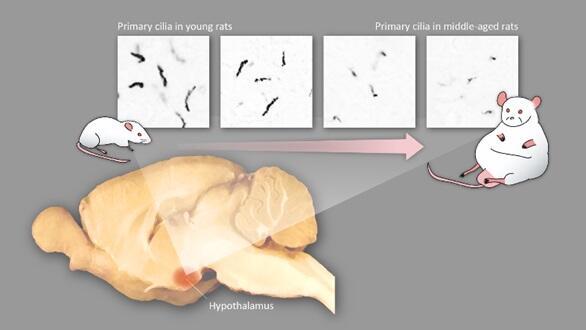A research group led by Assistant Professor Manami Oya, Lecturer Yoshiko Nakamura, and Professor Kazuhiro Nakamura of the Department of Integrative Physiology at Nagoya University Graduate School of Medicine, in collaboration with the Institute of Experimental Animal Sciences of the Graduate School of Medicine at Osaka University and the Institute of Medical Science at the University of Tokyo announced that they clarified the brain mechanism of age-related obesity (middle-age obesity). This mechanism was found by investigating age-related changes in the melanocortin-4 receptor with anti-obesity function in rats. They discovered that the receptor molecules localized to the primary cilia of hypothalamic neurons and that these cilia shorten with age. They confirmed that dietary restriction reverses ciliary shortening. The results are expected to contribute to the prevention of obesity and various diseases associated with obesity and were published in the March 7 issue of the international academic journal Cell Metabolism.

An increasing prevalence of obesity is a worldwide problem as it can lead to various lifestyle-related diseases such as diabetes and hypertension. When fat accumulates in the body, leptin is secreted from white adipocytes (fat cells) and acts in the hypothalamus. When melanocortin (MC: satiety signal molecule) secreted in the hypothalamus binds to the melanocortin-4 receptor (MC4R), a neural circuit is activated, showing anti-obesity effects through increased metabolic rate and heat production and reduced food intake. Causes of age-related obesity include age-related decline in overall body metabolism; however, the mechanism of age-related obesity remained unclear.
Due to this, the research group focused on MC4R, which exists in the hypothalamus in the brain and has an anti-obesity function. First, when 9-week-old (young) and 6-month-old (middle-aged) rats were subjected to cold stimuli, the thermogenic response as well as the circulatory response that enhances the heat-producing function of brown adipose tissue occurred in the young rats. In contrast, middle-aged rats showed a lower level of this response and had a decreased sensitivity to MC. To investigate the cause of this phenomenon, they examined age-related changes in the brain distribution of MC4R.
Visualization of the MC4R protein in rat brain with newly developed antibodies revealed that MC4R localized to the paraventricular hypothalamic nucleus and the dorsomedial hypothalamus, especially to the primary cilia of those neurons. Primary cilia are antenna structures found on most normal cells and thought to receive various signal molecules. A comparison of primary cilia at 3, 9, 15, and 24 weeks of age revealed that primary cilia shortened with age. A similar investigation of age-related changes in primary cilia under normal diet, high-fat diet, and food restriction (60% of normal) conditions showed that ciliary shortening under the high-fat diet condition was faster than that under the normal diet condition. Ciliary shortening was strongly inhibited by dietary restriction, indicating a correlation between the length of primary cilia and metabolic rate. Furthermore, artificial shortening of primary cilia in 9-week-old rats caused decreased metabolism, increased appetite, and increased body weight and body fat percentage, resulting in obesity. The group confirmed that these rats were less metabolically responsive to cold stimuli and also exhibited leptin resistance, which occurs in obese patients. They also studied genetically obese rats with mutations in a leptin receptor to investigate the mechanism of shortening of primary cilia. Contrary to their prediction, the rats had longer primary cilia.
These results suggest that leptin-melanocortin signaling may directly induce shortening of MC4R-localized primary cilia, and they tested this hypothesis. Long-term intracerebroventricular administration of leptin to wild-type rats for 5 weeks during which dietary restriction was imposed to inhibit shortening resulted in significant shortening of primary cilia. Chronic leptin treatment was found to promote shortening of primary cilia, putting the rats into a negative spiral of obesity. Furthermore, dietary restriction restored the length of primary cilia in 18-month-old mice, which was shortened under the normal diet condition. They also confirmed that ciliary shortening and weight gain can be inhibited by genetic manipulation. Age-related shortening of primary cilia is thought to occur in other primary cilia that do not have MC4R, and this may be a cause of various diseases.
Kazuhiro Nakamura said, "Moving forward, we would like to develop technologies to prevent lifestyle-related diseases at a preclinical stage and fundamental methods to prevent and treat obesity at the root. We will also need to verify in the future whether these results are applicable to humans."
Journal Information
Publication: Cell Metabolism
Title: Age-related ciliopathy: Obesogenic shortening of melanocortin-4 receptor-bearing neuronal primary cilia
DOI: 10.1016/j.cmet.2024.02.010
This article has been translated by JST with permission from The Science News Ltd. (https://sci-news.co.jp/). Unauthorized reproduction of the article and photographs is prohibited.




